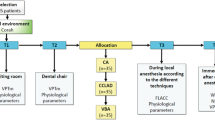Abstract
Aim: The aim is to investigate possible differences in discomfort during treatment with the atraumatic restorative treatment (ART) or the Conventional restorative method with and without local analgesia (LA). Methods: The study group consisted of 6 and 7 year-old children with no dental experience (mean age 6.98, SD± 0.52) randomly divided into four treatment groups: Conventional method with and without LA and ART with and without LA. One or two proximal lesions in primary molars were treated. The heart rate and the behaviour (Venham) were measured. Statistics: Statistical analysis was performed in SPSS version 10.0. Results: In a first session 300 children were treated and 109 children for a second time in the same way as at the first visit. During the first session ART without LA gave the least discomfort while the Conventional method without LA gave the most discomfort. During the second treatment the least discomfort was observed with ART without LA and the most discomfort in the Conventional way with LA. Conclusion: There is a constant preference for hand instruments; the bur is increasingly accepted. The experience with LA is the reverse.
Similar content being viewed by others
References
Aartman I, van Everdingen T, Hoogstraten J, Schuurs A. Self report measurements of dental anxiety and fear in children: A critical assessment. J Dent Child, 1998; 252–258.
Benjamins C (1995). Psychophysiological measurement of dental anxiety. Thesis Amsterdam: Academic Centre for Dentistry, The Netherlands, 1995.
Berge ten M. On the structure of childhood dental fear, using the dental subscale of the children’s fear survey schedule. Dental fear in children: prevalence, etiology and risk factors (chapter 3.2), PhD thesis, ACTA, Amsterdam, 2001.
Blount LB, Davis N, Powers SW, Roberts MC. The influence of environmental factors and coping style on children’s coping and distress. Clin Psychol Rev 1991;11: 93–116
Chambers CT, Craig KD. An intrusive impact of anchors in children’s faces pain scales. Pain 1998;78: 27–37
Frencken JE, Holmgren CJ. Atraumatic Restorative Treatment for dental caries 1st Ed., Nijmegen ISBN 906759024X, 1999
Frencken JE, Pilot T, Songpaisan Y, Phantumvanit P: Atraumatic restorative treatment (ART): rationale, technique, and development. J Public Health Dent 1996;56(3 Spec No):135–40
Gatchel RJ. Managing anxiety and pain during dental treatment J Am Dent Assoc 1992;123: 37–41
Holmgren CJ, Pilot T. Discussion from the symposium “Minimal intervention techniques for caries”. J Public Health Dent 1996;56: 161–163
Huskinsson EC. Measurement of Pain. The Lancet, 1974; 9: 1127–1131
Kleinknecht RA, Klepac RK, Alexander LD. Origins and characteristics of fear of dentistry. J Am Dent Assoc 1973;86: 842–848
Klingberg G, Vanas Löfqvist L, H wang CP. Validity of the Children’s Dental Fear Picture test (CDFP) Eur J Oral Sci 1995; 103: 55–60
Lenters M, Amerongen WE van, Mandari GJ. A measure of iatrogenic damage to the adjacent surfaces of deciduous molars, in three different ways of cavity preparation. Eur. Arch. Paed. Dent. 2006;7: 6–10
Liddell A, Locker D. Gender and age differences in attitudes to dental pain and dental control. Community Dent Oral Epidemiol 1997;25: 314–8
Lussi A, Gygax M: Iatrogenic damage to adjacent teeth during classical approximal box preparation. J Dent 1998;26(5–6):435–41.
Massara MLA, Alves JB, Brandão PRG. Atraumatic restorative treatment: clinical, ultrastructural and chemical analysis. Caries Res 2002;36: 430–36
McCarty CA, Weisz JR, Wanitromanee K, et al. Culture, coping, and context: primary and secondary control among Thai and American youth. J Child Psychol Psychiatry 1999 40(5): 809–18
Mhaville R, van Amerongen W.E, Mandari G. Radiographic assessment of residual caries and marginal integrity after preparation in three different ways and restoration with hand mixed glass-ionomer. Eur. Arch. Paed. Dent. 2006; in press
Milgrom P, Mancl L, King B, Weinstein P. Origins of childhood dental fear. Behav Res Ther 1995;33: 313–319
Milgrom P, Coldwell SE, Getz T, Weinstein P, Ramsay DS. Four dimensions of fear of dental injections. Journ Am Dent Assoc 1997;128: 756–62
Nakai Y, Milgrom P, Mancl L, Coldwell SE, Domoto et al. Effectiveness of local anaesthesia in pediatric dental practice. J Am Dent Assoc 2000;131:1699–1705.
Qvist V, Johannessen L, Bruun M: Progression of approximal caries in relation to iatrogenic preparation damage. J Dent Res 1992;71(7):1370–3.
Rahimtoola S, van Amerongen WE, Maher R, Groen H. Pain related to different ways of minimal intervention in the treatment of small caries lesions. J Dent Child 2000; 67:123–7.
Schriks MCM, van Amerongen WE. Atraumatic perspective of ART: p s y — chological and physiological aspects of treatment with and without rotary instruments. Community Dent Oral Epidemiol 2003;31:15–20.
Veerkamp JSJ, Gruythuysen RJM, Amerongen WE van, Hoogstraten J. Dental treatment of fearful children using nitrous oxide. Part 3, anxiety during sequential visits. J Dent Child 1993;60: 175–82.
Venham LL, Bengston D, Cipes M. Children’s response to sequential dental visits. J Dent Res 1977;56 (5):454–59.
Venham LL, Quatrocelli S. The young child’s response to repeated dental procedures. J Dent Res 1977;56 (7):734–38
Author information
Authors and Affiliations
Corresponding author
Rights and permissions
About this article
Cite this article
van Bochove, J.A., van Amerongen, W.E. The influence of restorative treatment approaches and the use of local analgesia, on the children’s discomfort. Eur Arch Paediatr Dent 1, 11–16 (2006). https://doi.org/10.1007/BF03320809
Published:
Issue Date:
DOI: https://doi.org/10.1007/BF03320809




